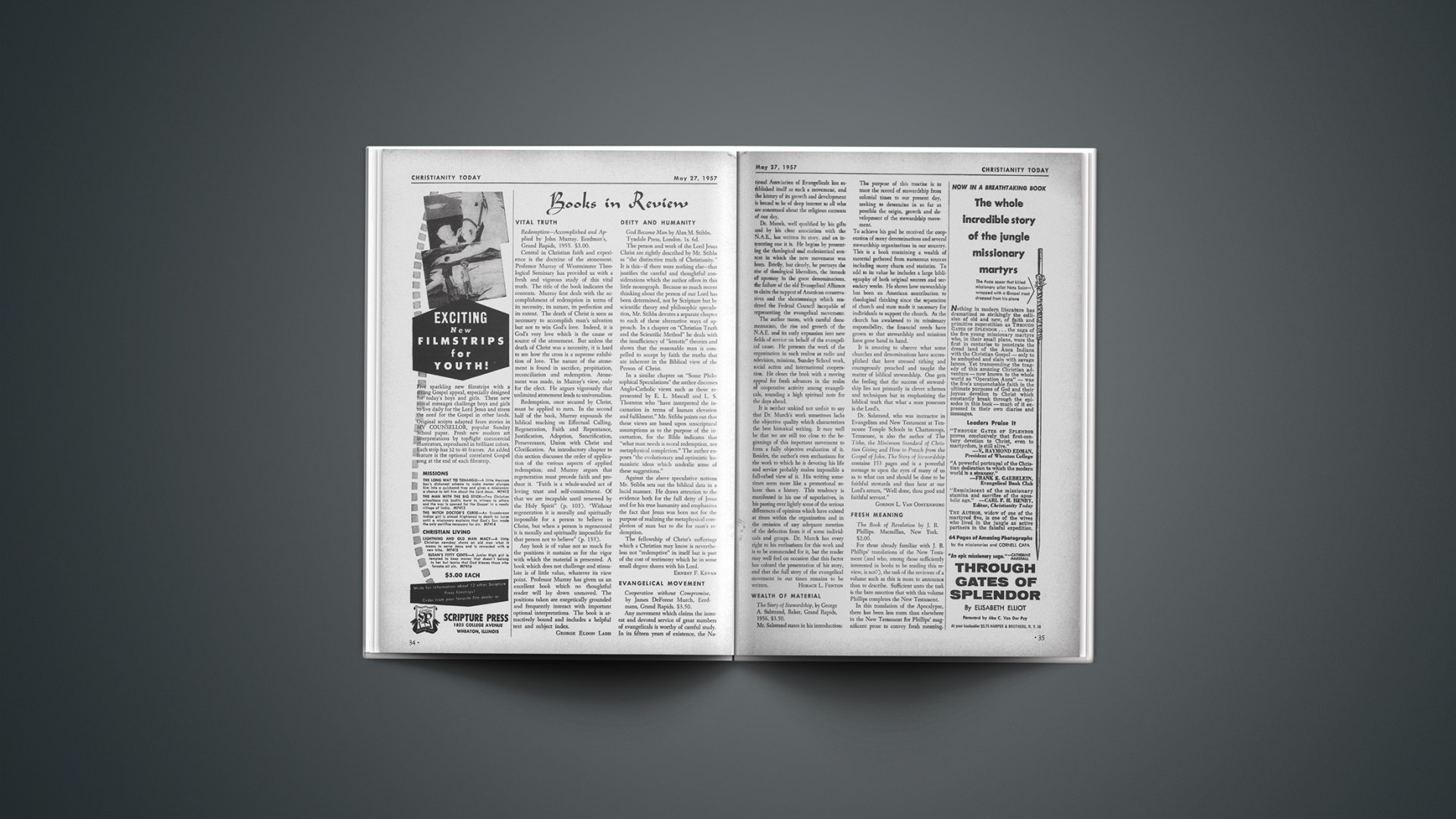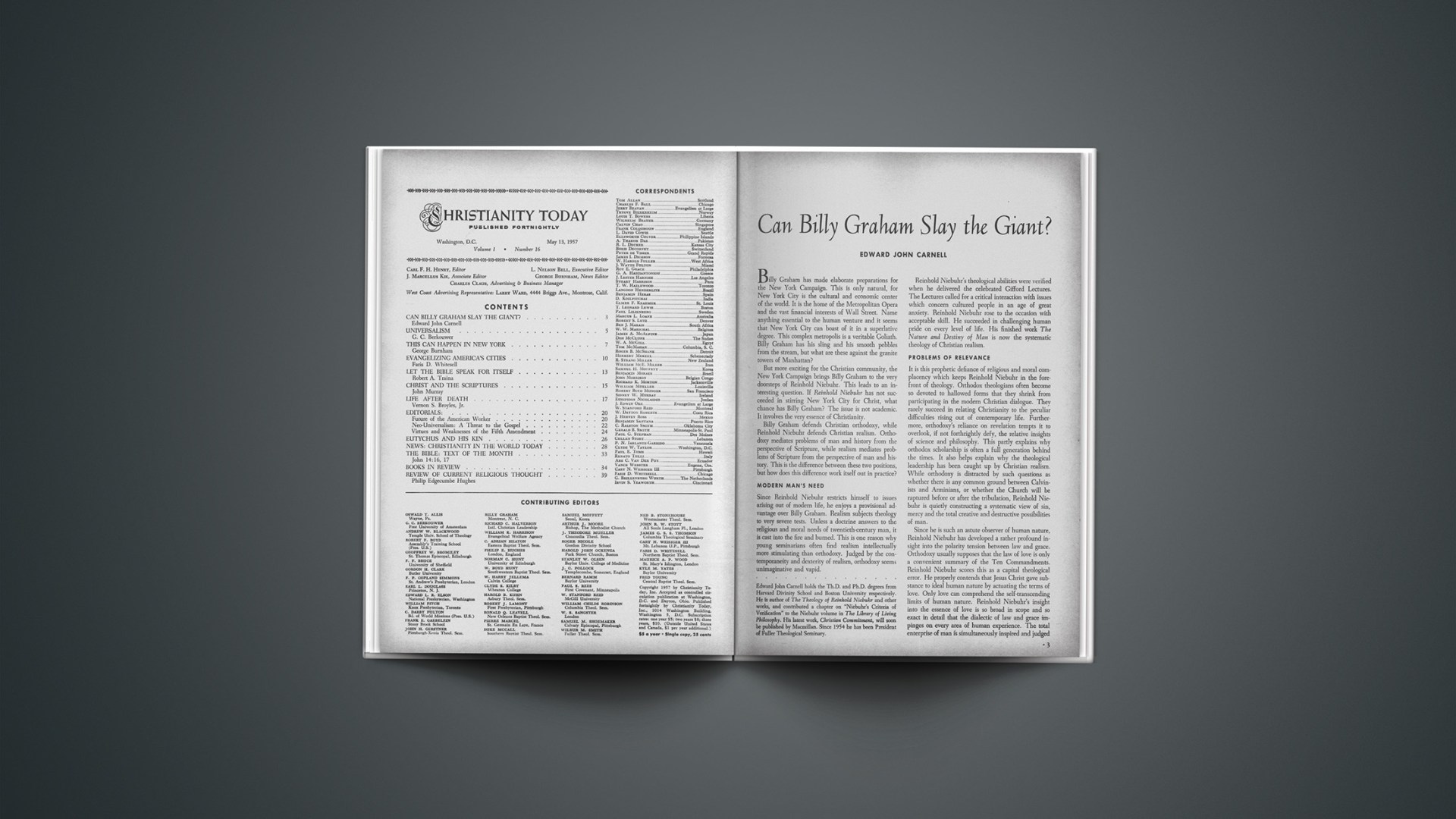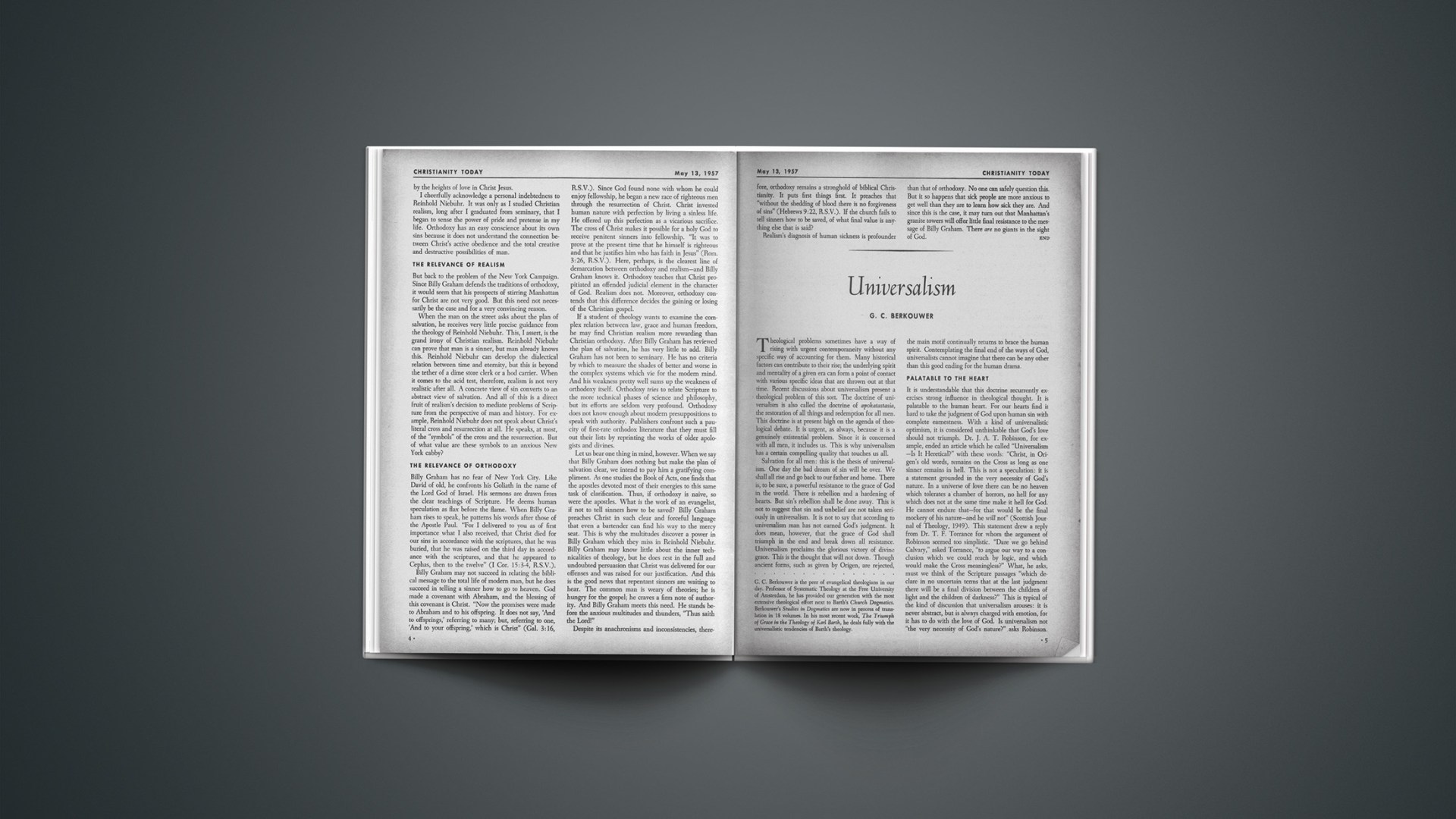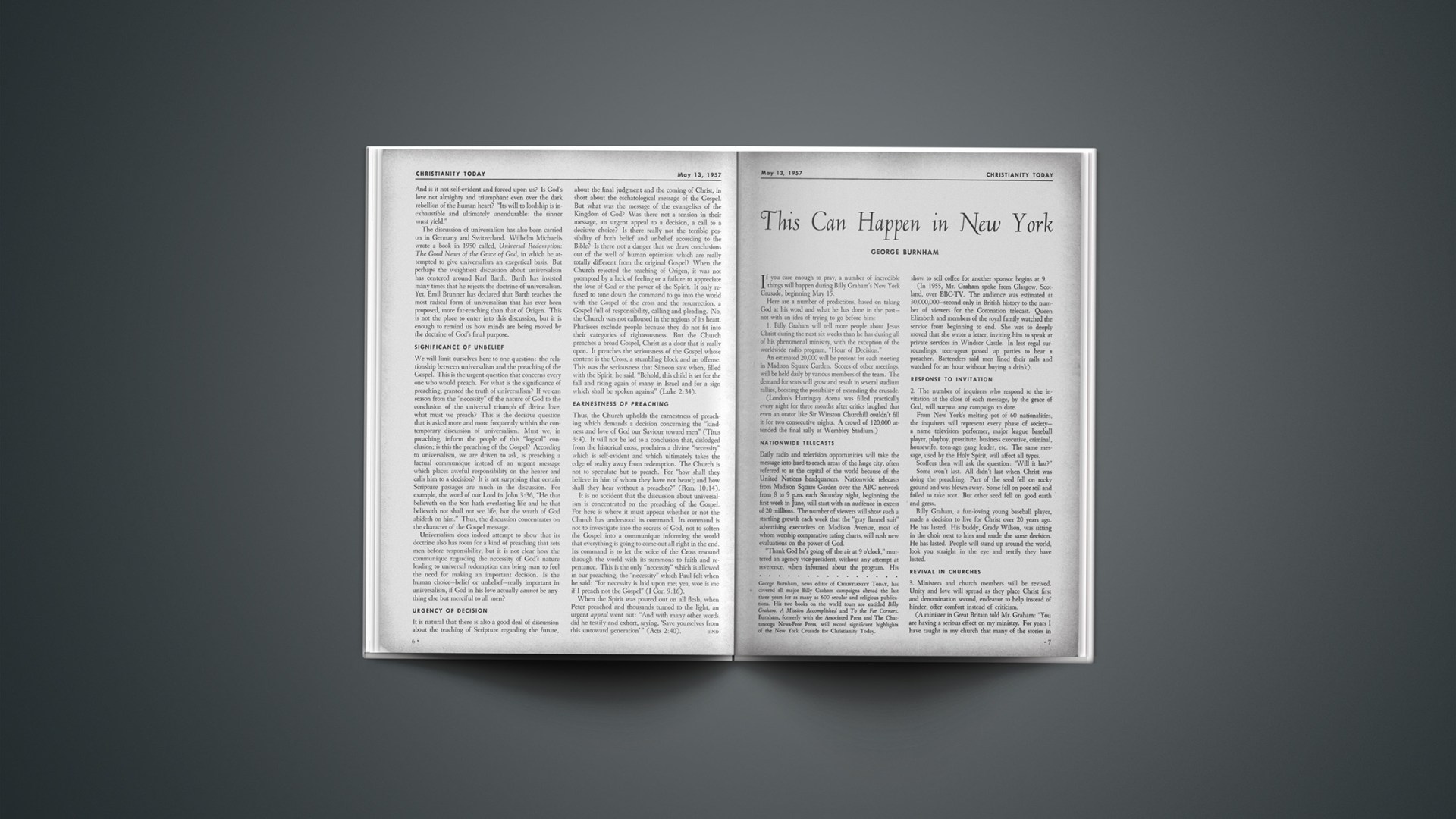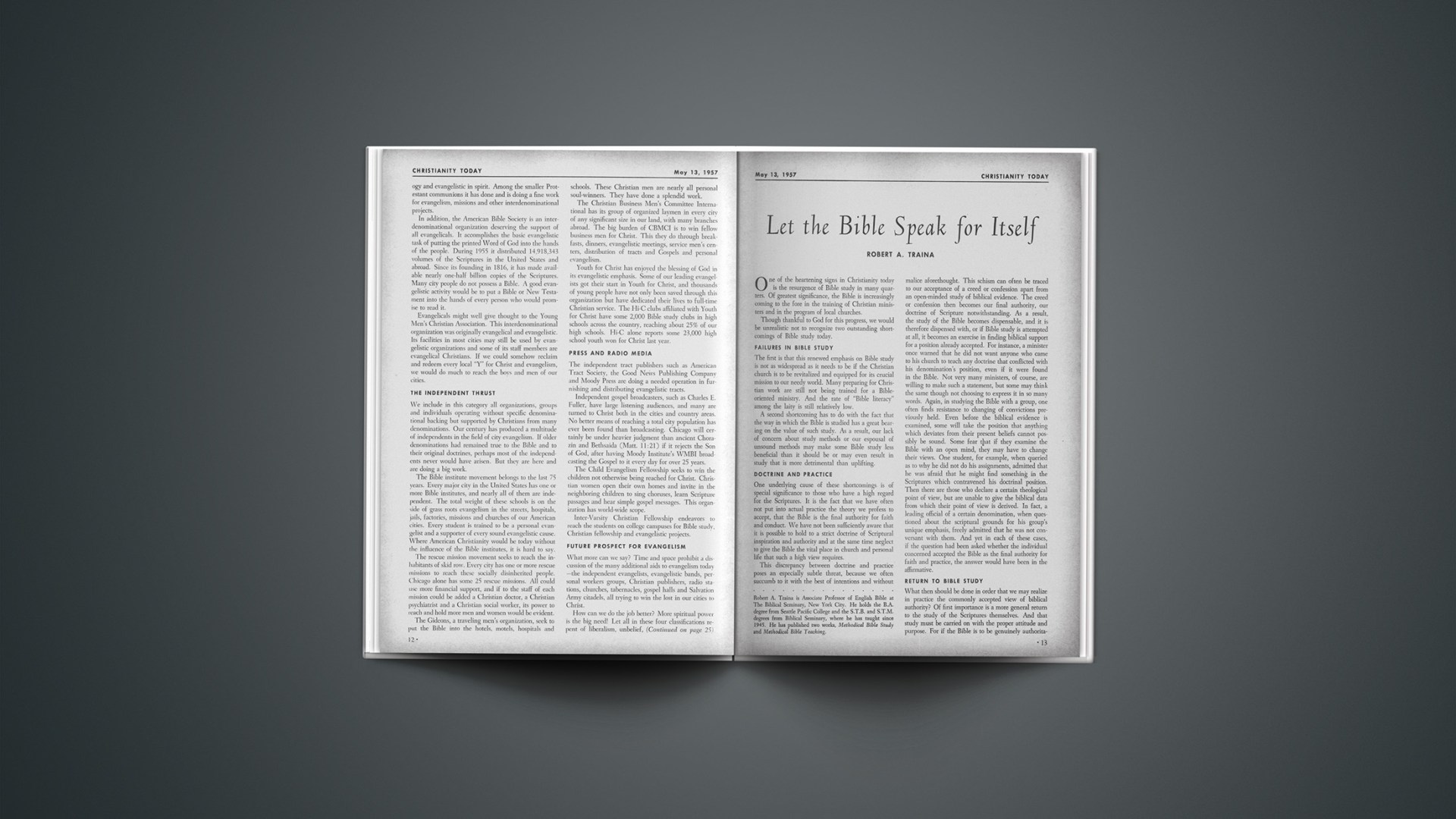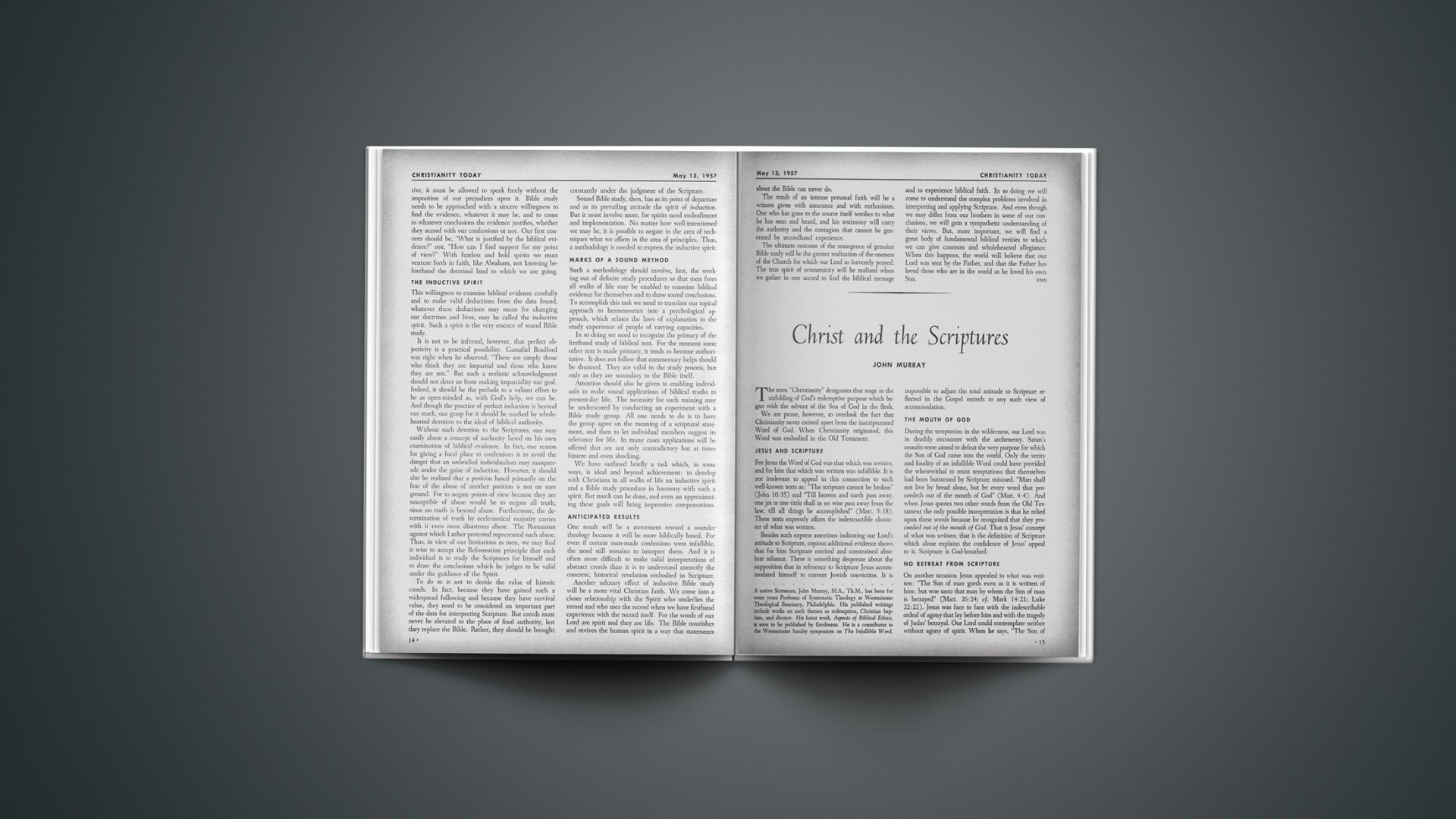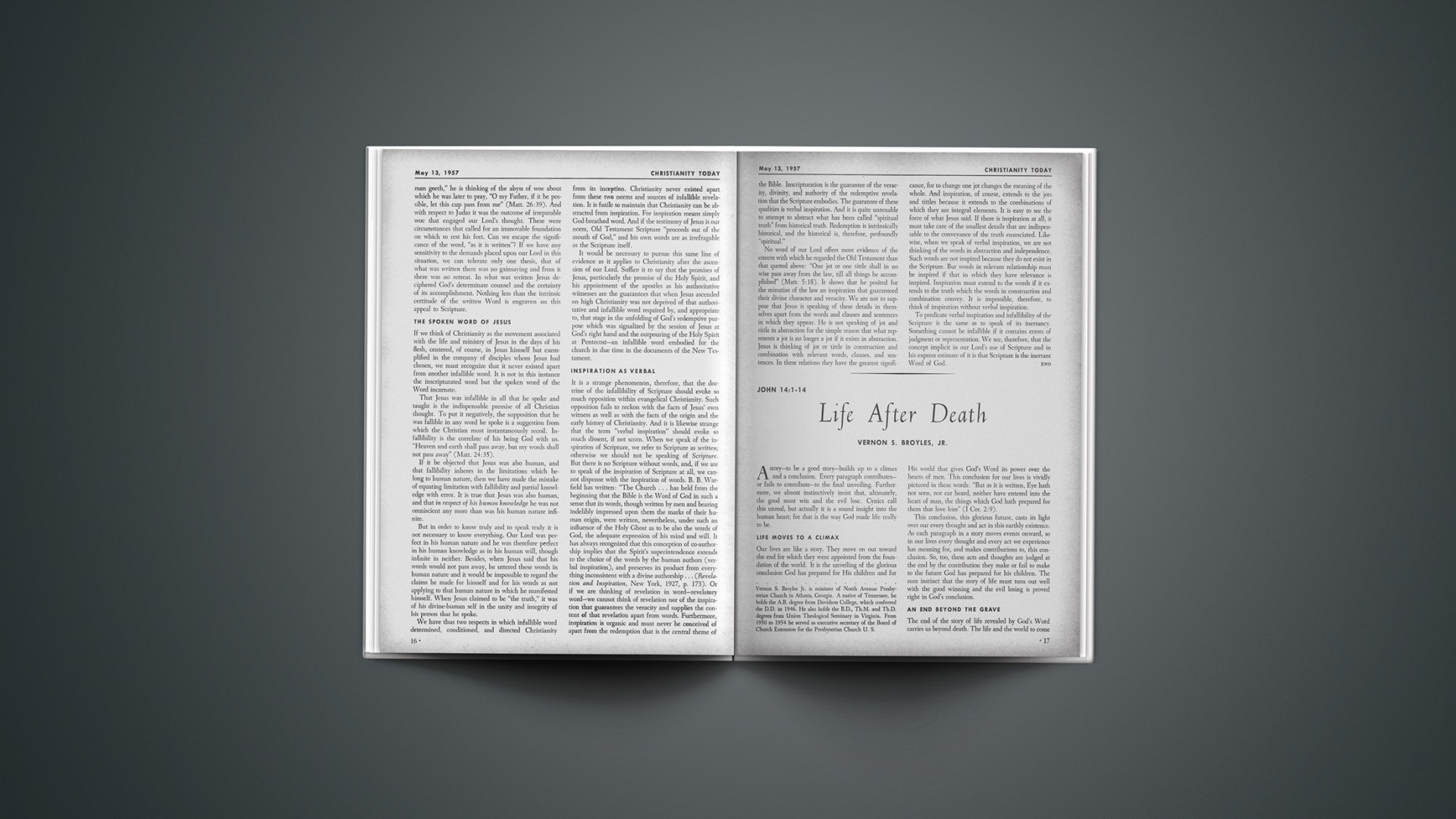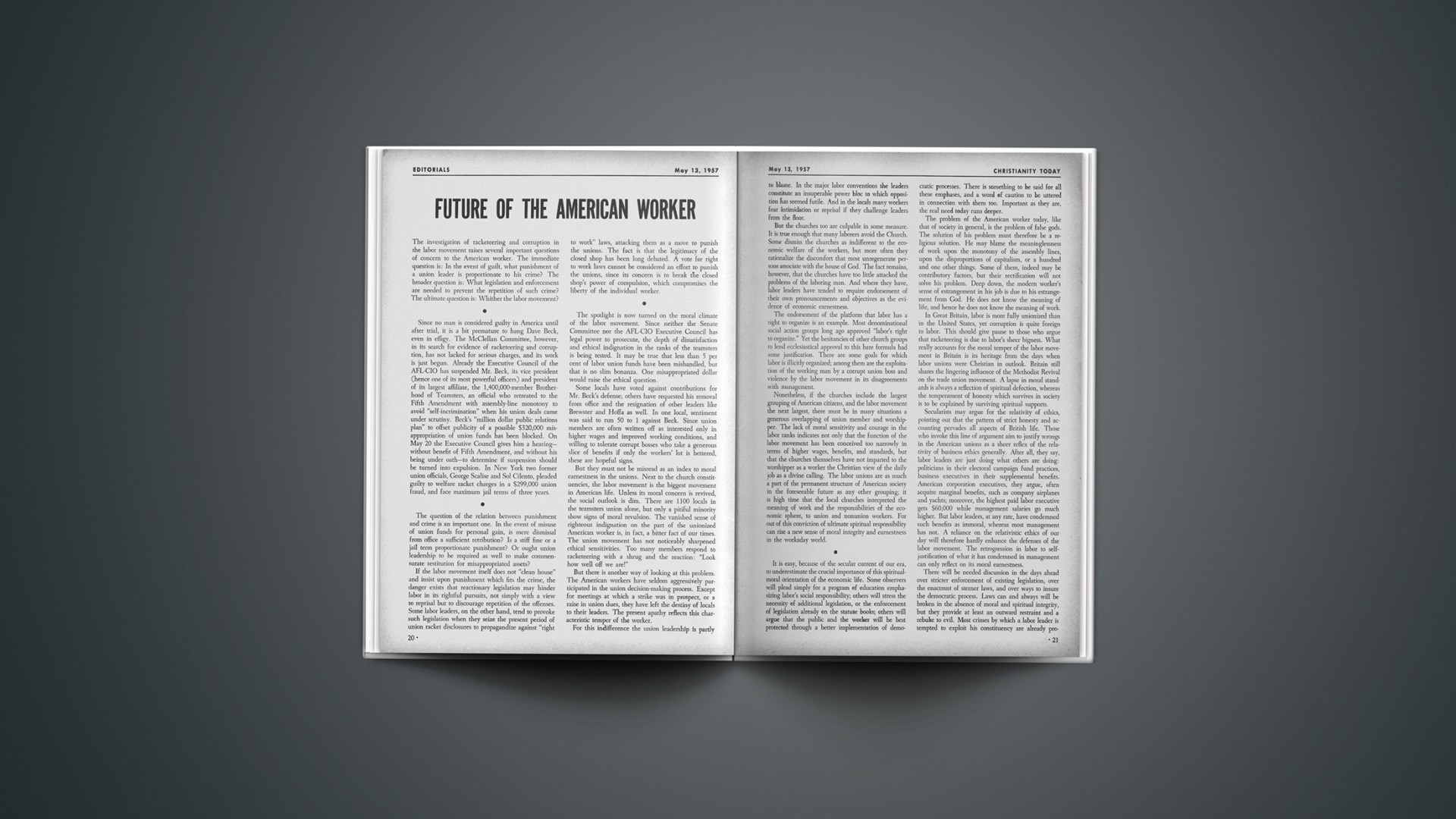Vital Truth
Redemption—Accomplished and Applied by John Murray. Eerdman’s, Grand Rapids, 1955. $3.00.
Central in Christian faith and experience is the doctrine of the atonement. Professor Murray of Westminster Theological Seminary has provided us with a fresh and vigorous study of this vital truth. The title of the book indicates the contents. Murray first deals with the accomplishment of redemption in terms of its necessity, its nature, its perfection and its extent. The death of Christ is seen as necessary to accomplish man’s salvation but not to win God’s love. Indeed, it is God’s very love which is the cause or source of the atonement. But unless the death of Christ was a necessity, it is hard to see how the cross is a supreme exhibition of love. The nature of the atonement is found in sacrifice, propitiation, reconciliation and redemption. Atonement was made, in Murray’s view, only for the elect. He argues vigorously that unlimited atonement leads to universalism.
Redemption, once secured by Christ, must be applied to men. In the second half of the book, Murray expounds the biblical teaching on Effectual Calling, Regeneration, Faith and Repentance, Justification, Adoption, Sanctification, Perseverance, Union with Christ and Glorification. An introductory chapter to this section discusses the order of application of the various aspects of applied redemption; and Murray argues that regeneration must precede faith and produce it. “Faith is a whole-souled act of loving trust and self-commitment. Of that we are incapable until renewed by the Holy Spirit” (p. 103). “Without regeneration it is morally and spiritually impossible for a person to believe in Christ, but when a person is regenerated it is morally and spiritually impossible for that person not to believe” (p. 133).
Any book is of value not so much for the positions it sustains as for the vigor with which the material is presented. A book which does not challenge and stimulate is of little value, whatever its view point. Professor Murray has given us an excellent book which no thoughtful reader will lay down unmoved. The positions taken are exegetically grounded and frequently interact with important optional interpretations. The book is attractively bound and includes a helpful text and subject index.
GEORGE ELDON LADD
Deity And Humanity
God Became Man by Alan M. Stibbs. Tyndale Press, London. 1s. 6d.
The person and work of the Lord Jesus Christ are rightly described by Mr. Stibbs as “the distinctive truth of Christianity.” It is this—if there were nothing else—that justifies the careful and thoughtful considerations which the author offers in this little monograph. Because so much recent thinking about the person of our Lord has been determined, not by Scripture but by scientific theory and philosophic speculation, Mr. Stibbs devotes a separate chapter to each of these alternative ways of approach. In a chapter on “Christian Truth and the Scientific Method” he deals with the insufficiency of “kenotic” theories and shows that the reasonable man is compelled to accept by faith the truths that are inherent in the Biblical view of the Person of Christ.
In a similar chapter on “Some Philosophical Speculations” the author discusses Anglo-Catholic views such as those represented by E. L. Mascall and L. S. Thornton who “have interpreted the incarnation in terms of human elevation and fulfilment.” Mr. Stibbs points out that these views are based upon unscriptural assumptions as to the purpose of the incarnation, for the Bible indicates that “what man needs is moral redemption, not metaphysical completion.” The author exposes “the evolutionary and optimistic humanistic ideas which underlie some of these suggestions.”
Against the above speculative notions Mr. Stibbs sets out the biblical data in a lucid manner. He draws attention to the evidence both for the full deity of Jesus and for his true humanity and emphasizes the fact that Jesus was born not for the purpose of realizing the metaphysical completion of man but to die for man’s redemption.
The fellowship of Christ’s sufferings which a Christian may know is nevertheless not “redemptive” in itself but is part of the cost of testimony which he in some small degree shares with his Lord.
ERNEST F. KEVAN
Evangelical Movement
Cooperation without Compromise, by James DeForest Murch, Eerdmans, Grand Rapids. $3.50.
Any movement which claims the interest and devoted service of great numbers of evangelicals is worthy of careful study. In its fifteen years of existence, the National Association of Evangelicals has established itself as such a movement, and the history of its growth and development is bound to be of deep interest to all who are concerned about the religious currents of our day.
Dr. Murch, well qualified by his gifts and by his close association with the N.A.E., has written its story, and an interesting one it is. He begins by presenting the theological and ecclesiastical context in which the new movement was born. Briefly, but clearly, he portrays the rise of theological liberalism, the inroads of apostasy in the great denominations, the failure of the old Evangelical Alliance to claim the support of American conservatives and the shortcomings which rendered the Federal Council incapable of representing the evangelical movement.
The author traces, with careful documentation, the rise and growth of the N.A.E. and its early expansion into new fields of service on behalf of the evangelical cause. He presents the work of the organization in such realms as radio and television, missions, Sunday School work, social action and international cooperation. He closes the book with a moving appeal for fresh advances in the realm of cooperative activity among evangelicals, sounding a high spiritual note for the days ahead.
It is neither unkind nor unfair to say that Dr. Murch’s work sometimes lacks the objective quality which characterizes the best historical writing. It may well be that we are still too close to the beginnings of this important movement to form a fully objective evaluation of it. Besides, the author’s own enthusiasm for the work to which he is devoting his life and service probably makes impossible a full-orbed view of it. His writing sometimes seem more like a promotional release than a history. This tendency is manifested in his use of superlatives, in his passing over lightly some of the serious differences of opinions which have existed at times within the organization and in the omission of any adequate mention of the defection from it of some individuals and groups. Dr. Murch has every right to his enthusiasm for this work and is to be commended for it, but the reader may well feel on occasion that this factor has colored the presentation of his story, and that the full story of the evangelical movement in our times remains to be written.
HORACE L. FENTON
Wealth Of Material
The Story of Stewardship, by George A. Salstrand, Baker, Grand Rapids, 1956. $3.50.
Mr. Salstrand states in his introduction: The purpose of this treatise is to trace the record of stewardship from colonial times to our present day, seeking to determine in so far as possible the origin, growth and development of the stewardship movement.
To achieve his goal he received the cooperation of many denominations and several stewardship organizations in our country. This is a book containing a wealth of material gathered from numerous sources including many charts and statistics. To add to its value he includes a large bibliography of both original sources and secondary works. He shows how stewardship has been an American contribution to theological thinking since the separation of church and state made it necessary for individuals to support the church. As the church has awakened to its missionary responsibility, the financial needs have grown so that stewardship and missions have gone hand in hand.
It is amazing to observe what some churches and denominations have accomplished that have stressed tithing and courageously preached and taught the matter of biblical stewardship. One gets the feeling that the success of stewardship lies not primarily in clever schemes and techniques but in emphasizing the biblical truth that what a man possesses is the Lord’s.
Dr. Salstrand, who was instructor in Evangelism and New Testament at Tennessee Temple Schools in Chattanooga, Tennessee, is also the author of The Tithe, the Minimum Standard of Christian Giving and How to Preach from the Gospel of John. The Story of Stewardship contains 153 pages and is a powerful message to open the eyes of many of us as to what can and should be done to be faithful stewards and thus hear at our Lord’s return, “Well done, thou good and faithful servant.”
GORDON L. VAN OOSTENBURG
Fresh Meaning
The Book of Revelation by J. B. Phillips. Macmillan, New York. $2.00.
For those already familiar with J. B. Phillips’ translations of the New Testament (and who, among those sufficiently interested in books to be reading this review, is not?), the task of the reviewer of a volume such as this is more to announce than to describe. Sufficient unto the task is the bare assertion that with this volume Phillips completes the New Testament.
In this translation of the Apocalypse, there has been less room than elsewhere in the New Testament for Phillips’ magnificent prose to convey fresh meaning. The account is too factual to lend itself well to the sort of interpretative writing for which the author is justly famous. On the other hand, by the use of tenses and idioms, it has been possible for him to convey meaning where before there was obscurity. Occasionally this is very refreshing. Occasionally it makes one pause.
For instance, in chapter 4, Phillips uses a continuous present tense to convey a dramatic impression of never-ending worship which is quite effective. But he translates the familiar “He that hath an ear …” by “Let the listener hear …” which, to this reviewer, weakens the suggested selectivity implied by the phrase. A similar weakness of idiom occurs elsewhere as, for instance, in the next-to-last verse in the book where “He which testifieth these things …” becomes “He who is witness to all this.…”
G. AIKEN TAYLOR
Light On The Scrolls
Second Thoughts on the Dead Sea Scrolls by F. F. Bruce. Paternoster Press, London, 1956. 10s. 6d.
The Teacher of Righteousness in the Qumran Text by F. F. Bruce. Tyndale Press, London, 1957 2s.
Discriminating readers will distinguish between the reliable and the sensational books on the Scrolls. All books on the subject at present must contain considerable speculation, but in several cases hypothesis has been presented virtually as fact.
Professor Bruce’s book and his monograph are reliable treatments, and the reader is clearly shown the boundary between fact and conclusion. The book tells the story of the discovery of the Scrolls, their dating and the type of community from which they emanated. A chapter setting forth their bearing on the O.T. text is followed by a discussion of how the Qumran commentators treated the Messianic hope. Prof. Bruce points out that whereas Qumran looked for what we might call both a sacred and a secular Messiah, the N.T. finds all the O.T. prophecies fulfilled in the one person of Jesus Christ.
Who is the Teacher of Righteousness who is so greatly venerated by the community? Prof. Bruce holds that at present the evidence is insufficient to identify him with any known character of history, but he inclines tentatively to the view that the Wicked Priest, who persecuted him, is Alexander Jannaeus.
In estimating the relationship of the Qumran community to primitive Christianity, it is unlikely that the Teacher was himself regarded as the Messiah, nor was there any saving efficacy in his death.
Certain ideas are obviously common to any religion that is grounded on the O.T., and these must not be treated as though Christ and his disciples drew their teaching from Qumran. Yet the Scrolls have shown some interesting points of contact between the vocabularies of Qumran and St. John’s Gospel, indicating that some features that were formerly traced to Greek sources are likely to have been already current coin in Palestine in the time of Christ.
J. STAFFORD WRIGHT
Calvin Revival
American Calvinism, a Survey edited by Jacob T. Hoogstra. Baker, Grand Rapids. $2.50.
About twenty years ago Georgia Harkness wrote, “Calvin’s theology is in eclipse. Nobody now accepts his strange ideas.” After reading this survey of contemporary American Calvinism, one is not likely to accept Georgia Harkness’ judgment for 1957. The spirit of the times has changed. There is a great new interest in Calvin among students in the Southern Presbyterian Church. The same is true in the Reformed Church of America and in some seminaries of the Presbyterian Church. New translations of The Institutes have appeared in Hungarian, German and French; new printings have appeared in English also.
These and other facts are included in this unusual volume which embodies the talks given at the Calvinistic Conference held in Grand Rapids, Michigan, on June 20, 21, 1956. The Conference was sponsored by the American Branch of the International Association of Reformed Faith and Action. Speakers included John H. Gerstner (Pittsburgh-Xenia), Paul Woolley (Westminster), Donald F. Tweedie (Gordon), J. Moody McDill (Pastor, Southern Presbyterian), Jerome DeJong (Pastor, Reformed Church of America), Jacob T. Hoogstra (Pastor, Christian Reformed Church), Cornelius Jaarsma (Calvin) and M. Eugene Oosterhaven (Western, Holland, Michigan).
The two papers by Gerstner and Woolley are well worth the price of the entire book. Prof. Gerstner sketches the history of Calvinism in the United States, especially in New England, before 1900. This is his field. Not only does he know the dominant characters but he knows their theology. He has the knack of painting with broad strokes the sweeping movements and then filling the canvas with details. Prof. Woolley takes up the picture with Darbyism and traces the social and doctrinal difficulties of the Northern Presbyterians to the present day expanding interest of the Reformed churches in Christian education and evangelism.
There follow ecclesiastical surveys of the various regions of our country. These are well done and form a basis for the growing optimism of Calvinists. It is regrettable that a survey of the North-Eastern region was not given. Many would like to know what theological direction Harvard is taking in 1957.
The inclusion of the discussion which followed each paper gives the reader the feeling he is listening in on a Calvinistic “bull-session”!
The collaborators on this book represent a broad front of Calvinism, as evidenced by their attempts to define it. Their talks cover American Calvinism in a comprehensive sweep.
FRANK LAWRENCE
Thematic Interpretation
Philippians, The Gospel at Work by Merril C. Tenney. Eerdmans, Grand Rapids. 1956.
Immediately upon seeing a new book on Philippians, two questions come to my mind. (1) How has the author treated the Kenosis passage, and (2) how are the key words translated and applied? Satisfaction for both questions is to be found in The Gospel at Work. This is an “in between” book. It is not a comprehensive commentary of the Epistle to the Philippians, but neither is it a “thin” book in the sense of lack of scholarship or purpose. It is small, but it is filled with good things.
While completely “fair” with the text, a contemporary note is maintained throughout by the illustrations and applications utilized. Historical unity is maintained by frequent reference to Paul’s experiences in Philippi and also to his knowledge of the needs of that church.
The author has chosen thematic interpretation as his literary method; a natural method derived from the fact that the chapters of his book were originally lectures given in the spring of 1955 at Goshen College, Goshen, Indiana. The theme is built around the nine appearances of the word “gospel” in the Philippians.
Five divisions; i. e. “Beginning”, “Fellowship”, “Pattern”, “Experience” and “Effects” are then developed. In interpretation, the author seems to be motivated by a desire to help rather than to dogmatize, and where necessary he will use variants of a text to make the meaning clear, including personal translation.
Each section of Philippians receives approximately equal treatment, including an analysis of Paul’s autobiography in chapter three. The “humiliation and exaltation” passage is treated briefly but adequately. The reader can be satisfied with what is there. In many instances, suboutlining by the paragraph and italics method makes the points more readily available.
As I read, I kept waiting for something to be said about the peculiar political status of the city of Philippi in the Roman system. This appeared in the last chapter; I could wish that there had been more.
ROBERT WINSTON ROSS

